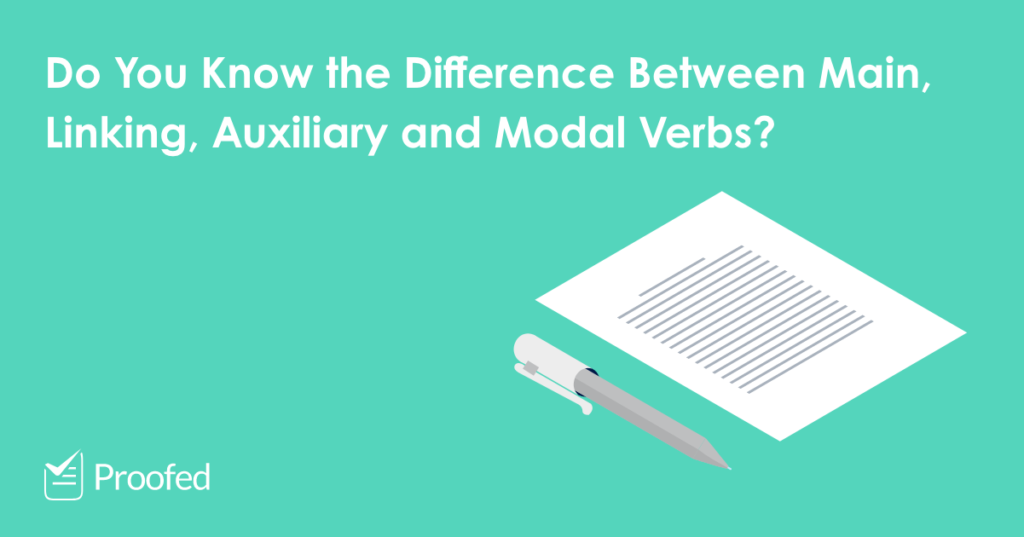You might know that verbs express actions and states of being. But did you know there are different verb types? These include:
- Main verbs – A “main” verb expresses an action, event, or state.
- Linking verbs – A type of verb that describes the subject of a sentence.
- Auxiliary verbs – Also known as “helper verbs,” these work alongside a main verb to express different tenses and grammatical moods.
- Modal verbs – These help us express necessity or probability.
While not essential, knowing how these verb types differ from one another can help you avoid errors in your writing. In the rest of this post, then, we’ll look more closely at how to use all the verb types listed above.
1. Main Verbs
Typically, a main verb (also known as a lexical or principal verb) in a sentence tells us what the subject is doing or their state of being:
He kicked the ball.
She is a scientist.
We’re learning a lot about verb types!
Every complete sentence will include at least one main verb, and this might be the only verb in a sentence (unlike auxiliary or modal verbs).
In addition, action verbs will always be transitive or intransitive:
- Transitive verbs need an object (i.e., the thing the verb affects).
- Intransitive verbs can be used without an object.
Some verbs, though, can be either transitive or intransitive depending on how we use them. Take the verb “walk,” for example:
Transitive: She walked the dog.
Intransitive: We walked to the party.
In the first sentence, we’re using “walk” to mean “take something for a walk,” so we need an object (i.e., “dog”). But in the second, “walked” does not need an object for us to know what it means (i.e., the speakers arrived on foot).
In all cases, though, the main verb is the most important verb in a sentence.
2. Linking Verbs
Linking verbs, also known as “copular verbs,” are a type of main verb that connects the subject to further information about it. For example:
Thomas seems happy.
Here, we use the linking verb “seems” to connect the subject (i.e., “Thomas”) with a description of their apparent state of being (i.e., “happy”). This extra information after the verb is known as a subject complement.
As well as “seem,” common linking verbs include “be,” “become,” and “appear.” Others are related to the senses, such as “taste,” “look,” and “smell”:
That cake smells delicious.
Find this useful?
Subscribe to our newsletter and get writing tips from our editors straight to your inbox.
Importantly, linking verbs do not express actions. Rather, they tell us what the subject is or their current state of being, not what the subject is doing.
3. Auxiliary Verbs
Auxiliary verbs help us to express a verb tense or grammatical mood. This is why they’re also sometimes known as “helper verbs.”
A helper verb will always come before the main verb in a sentence. The three main examples in English are “be,” “do,” and “have.” For example:
I am taking a break.
Here, by using the auxiliary verb “am” (a form of “be”) with the present participle “taking,” we form the present continuous tense.
In the following, meanwhile, we use “does” (a form of “do”) along with the main verb “want” to form the interrogative mood (i.e., ask a question):
Does Jim want a beer?
“Be,” “do,” and “have” can also be the main verb in a sentence in some cases (e.g., “She is a teacher”). But when they’re used alongside another verb, like in the examples above, they will usually function as helper verbs.
4. Modal Verbs
Modal verbs include “can,” “may,” “must,” “should,” “would,” “might,” and “will.” We can use them alongside another verb to express several things:
- How likely something is (e.g., We might go out for dinner tonight)
- Obligation (e.g., Rita should visit her grandparents)
- Capability (e.g., He can run very fast)
- Permission (e.g., You may leave early today)
In addition, we can use modal verbs to offer something:
Would you like a mint?
They are also known as “modal auxiliary verbs” since, like auxiliary verbs, they help the main verb in a sentence. However, you would not usually use any modal verb by itself unless the context made the main verb clear:
Liz: Will you close the window, Tom?
Tom: I will.
Here, Tom can use “will” by itself because it is clear he’s referring to closing the window. But you wouldn’t use “I will” by itself out of context.
The Benefits of Proofreading
Hopefully, this post has helped to explain the basic verb types in English. As noted, though, some of these types overlap (e.g., a linking verb is often also the main verb in a sentence). And this can make grammar tricky!
Luckily, if you’re ever unsure about verb forms or any other aspect of your writing, we have grammar experts ready to help. Simply submit a free trial document for proofreading to find out more.



